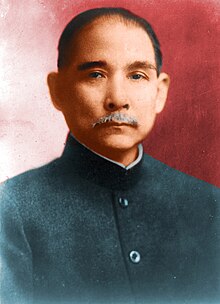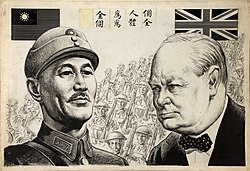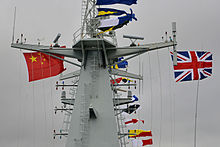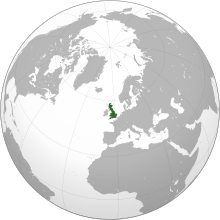Medieval[edit]
Rabban Bar Sauma from China visited France and met with King Edward I of England in Gascony.Between England and the Ming Dynasty (1368–1644)[edit]
- English ships sailed to Macau in the 1620s, which was leased by China to Portugal. The Unicorn, an English merchant ship, sank near Macau and the Portuguese dredged up sakers (cannon) from the ships and sold those to China around 1620, where they were reproduced as Hongyipao.
- 27 June 1637: Four heavily armed ships under Captain John Weddell, arrived at Macao in an attempt to open trade between England and China. They were not backed by the East India Company, but rather by a private group led by Sir William Courteen, including King Charles I's personal interest of £10,000. They were opposed by the Portuguese authorities in Macao (as their agreements with China required) and quickly infuriated the Ming authorities. Later, in the summer, they easily captured one of the Bogue forts, and spend several weeks engaged in low-level fighting and smuggling. After being forced to seek Portuguese help in the release of three hostages, they left the Pearl River on 27 December. It is unclear whether they returned home.[1][2][3]
Great Britain and the Qing Dynasty (1644–1911)[edit]

Skilled diplomat, Li Hongzhang acted as a negotiator between the West and the late Qing Dynasty. Queen Victoria made him a Knight Grand Cross of the Royal Victorian Order.
- 1685 Michael Shen Fu-Tsung visits Britain and meets James II.[4]
- 1793 George Macartney, 1st Earl Macartney led the Macartney Embassy to Beijing
- 1816 William Pitt Amherst, 1st Earl Amherst led the Amherst Embassy to China.
- ca. 1820-1830 - British merchants turn Lintin Island in the Pearl River estuary into a centre of opium trade.[5][6]
- 1839-42 First Opium War
- 1841 - Convention of Chuenpi, intended to end the war and to cede Hong Kong Island to the British, signed, but never ratified
- 29 August 1842 - Treaty of Nanking ends the war. It includes the cession of Hong Kong Island to the British, and opening of five treaty ports to international trade[7]
- October 1843 - Treaty of the Bogue supplements Treaty of Nanking by granting extraterritoriality to British subjects in China and most favored nation status to Britain
- 1856-60 Second Opium War
- June 1858 - The Treaty of Tientsin is signed by Lord Elgin
- October 1860 - the sack and destruction of the Old Summer Palace by the victorious British and French troops
- October 1860 - Convention of Peking ends the war. Kowloon Peninsula is ceded to Britain
- 26 March 1861 - In accordance with the treaties, a British Legation opens in Beijing (Peking). In the following few years consulates open throughout the Empire, including Hankou (Wuhan), Takao (Kaohsiung), Tamsui (near Taipei), Shanghai and Xiamen.
- 1868 - The Yangzhou riot.
- 1875 - The Margary Affair.
- 1877 - A Chinese Legation opens in London under Guo Songtao (Kuo Sung-t'ao)
- 1877-1881 - Britain advises on the Ili Crisis.
- 1886 - After Britain took over Burma, they maintained the sending of tribute to China, putting themselves in a lower status than in their previous relations.[8] It was agreed in the Burmah convention in 1886, that China would recognise Britain's occupation of Upper Burmah while Britain continued the Burmese payment of tribute every ten years to Beijing.[9]
- 1888 - War in Sikkim between the British and Tibetans. By the Treaty of Calcutta (1890), China recognises British suzerainty over northern Sikkim.
- 17 March 1890 Convention Between Great Britain and China relating to Sikkim & Tibet, fixes the border between Sikkim and Tibet.[10]
- 1896 - Sun Yat-sen is detained in the Chinese Legation in London. Under pressure from the British public, the Foreign Office secures his release.
- 9 June 1898 - Convention for the Extension of Hong Kong Territory (Second Convention of Peking): New Territories are leased to Britain for 99 years, and are incorporated in Hong Kong
- 1898 - The British obtain a lease on Weihai Harbour, Shandong, to run for as long as the Russians lease Port Arthur. (The reference to the Russians was replaced with one to the Japanese after 1905). An incident occurred where Mail-steamers arrived in Shanghai and dropped off "four young English girls" in December 1898.[11][12][13][14]
- 1900-1901 - The Boxer Rebellion
- 1901 - The Boxer Protocol
- 1906 - Anglo-Chinese Treaty on Tibet, which London interprets as limiting China to suzerainty over the region
- 1909 - The Japanese Government claims foreign consulates in Taiwan; the British consulates at Tamsui and Takoa close the following year.
Britain and the Republic of China (1912–present)[edit]

British diplomats rescued Sun Yat-sen from their Qing counterparts in 1896. Sun later founded the Republic of China.
- 1916 - The Chinese Labour Corps recruits Chinese labourers to aid the British during World War I.
- 14 August 1917 - China joins Britain as part of the Allies of World War I.
- 4 May 1919 - The anti-imperialist May Fourth Movement begins in response to the Beiyang government's failure to secure a share of the victory spoils from the leading Allied Powers, after Britain sides with its treaty ally Japan on the Shandong Problem. From this point the ROC leadership moves away from Western models and towards the Soviet Union.
- November 1921-February 1922. At the Washington naval disarmament conference rivalries persisted over China. The United States, Japan and Britain supported different warlords. The US and Britain were hostile to the nationalists revolutionary government in Guangzhou (Canton) and supported Chen Jiongming's rebellion. Chinese reactions led to the Northern Expedition (1926-27).[15]
- 30 May 1925 - Shanghai Municipal Police officers under British leadership kill nine people while trying to defend a police station from Chinese protesters, provoking the anti-British campaign known as the May 30 Movement.
- 19 February 1927 - Following riots on the streets of Hankow (Wuhan) the Chen-O'Malley Agreement is entered into providing for the hand over of the British Concession area to the Chinese authorities.
- 1930 - Weihai Harbour returned to China.
- 17 May 1935 - Following decades of Chinese complaints about the low rank of Western diplomats, the British Legation in Beijing is upgraded to an Embassy.[16]
- 1936-37 - British Embassy moves to Nanjing (Nanking), following the earlier transfer there of the Chinese capital.
- 1937-41 - British public and official opinion favours China in its war against Japan, but Britain focuses on defending Singapore and the Empire and can give little help. It does provide training in India for Chinese infantry divisions, and air bases in India used by the Americans to fly supplies and warplanes to China.[17]
- 1941-45 - Chinese and British fight side by side against Japan in World War II. The British train Chinese troops in India and use them in the Burma campaign.
- 6 January 1950 - His Majesty's Government (HMG) removes recognition from the Republic of China. The Nanjing Embassy is then wound down. The Tamsui Consulate is kept open under the guise of liaison with the Taiwan Provincial Government.
- 13 March 1972 - The Tamsui Consulate is closed.[18]
- February 1976 - The Anglo Taiwan Trade Committee is formed to promote trade between Britain and Taiwan.[19]
- 30 June 1980 - Fort San Domingo is seized by the Republic of China authorities in lieu of unpaid rent.[18]
- 1989 - The Anglo Taiwan Trade Committee begins issuing British visas in Taipei.
- 1993 - British Trade and Cultural Office opened in Taipei.[20]
Between the UK and the People's Republic of China (1949–present)[edit]
By August 1948, however, the Communists' victories caused the British government to begin preparing for a Communist takeover of the country. It kept open consulates in Communist-controlled areas and rejected the Nationalists' requests that British citizens assist in the defence of Shanghai. By December, the government concluded that although British property in China would likely be nationalised, British traders would benefit in the long run from a stable, industrialising Communist China. Retaining Hong Kong was especially important; although the Communists promised to not interfere with its rule, Britain reinforced the Hong Kong Garrison during 1949. When the victorious Communist government declared on 1 October 1949 that it would exchange diplomats with any country that ended relations with the Nationalists, Britain—after discussions with other Commonwealth members and European countries—formally recognised the People's Republic of China in January 1950.[21]










